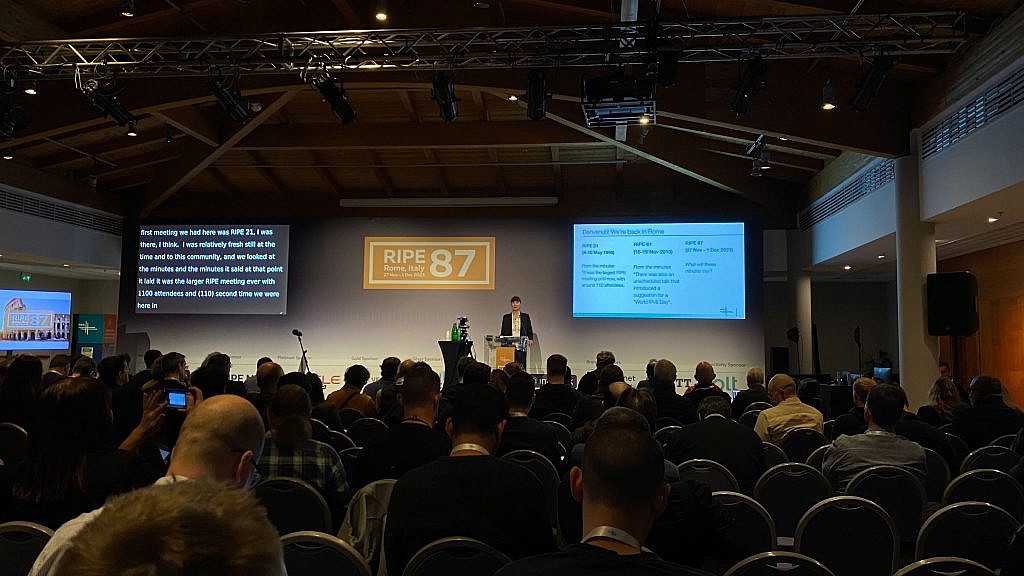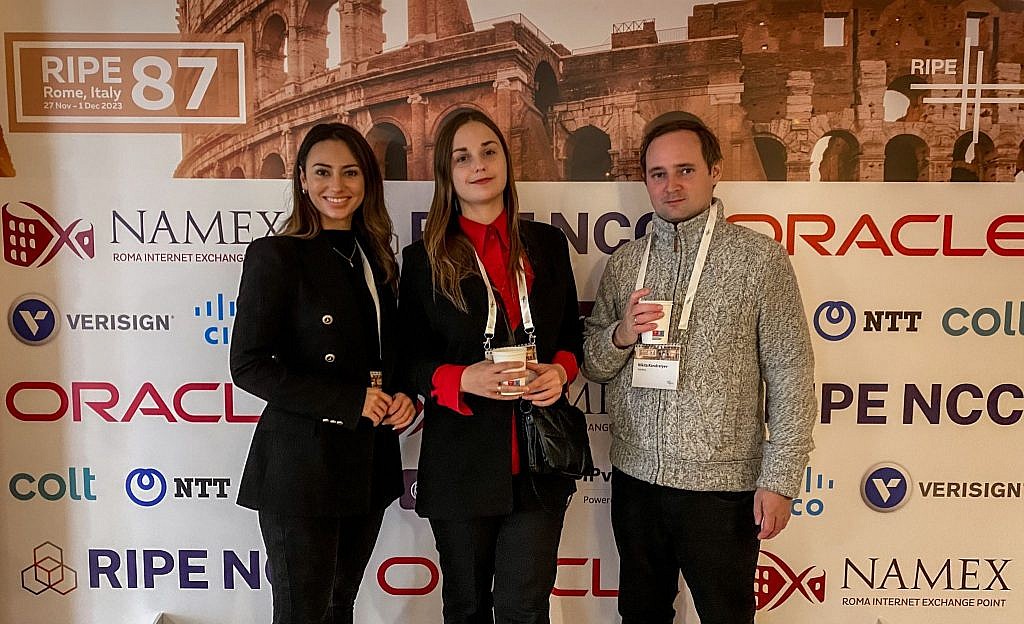Introduction
The Voldeta team participated in the RIPE87 conference, a 5-day event held in Rome from November 27 to December 2. In this summary, we’ve outlined key highlights for your convenience, offering concise descriptions of keynote presentations, updates in RIPE policies, outcomes from the RIPE General Meeting (GM), and results of the NRO voting.
This Article will help keep you informed about the latest news in the world of the Internet.
Part 1. Key Presentations.
Throughout the event, numerous interesting presentations were delivered, and we would like to highlight five of them.
- Tomorrow’s Internet must sleep more and grow old by Romain Jacob, ETH Zürich.
This report was dedicated to sustainable development in Data Centers and Telco Networks. The author poses the question of who consumes more energy: Data Centers or Telco Networks and provides various statistical data from several years. The data suggests that ultimately, Telco Networks consume slightly more energy, and there is a growing trend in energy consumption in both industries year after year. The author notes that energy is consumed fairly efficiently, but this is deemed insufficient. Expanding network capacity is a straightforward task, but enhancing energy efficiency poses a greater challenge. Consequently, total energy consumption is expected to rise, resulting in an increased carbon footprint.
To address the issue, the author suggests the following:
- Reduce operational footprint with better proportionality by “turning off “stuff” whenever possible.
Challenges: In practice, transceivers take 1000 times longer to start than needed for energy savings through buffering. Due to a lack of data and suitable equipment, it is currently impossible to calculate how much energy would actually be saved by transitioning to a “sleep” mode.
2. Reduce embodied footprint with sustainable procurement. The offered solution is: to use hardware longer.
For consumer devices, the embodied footprint dominates. For networked devices, it tends to be the opposite, the operational footprint dominates.
Challenges: Less reliable. Less secure. Harder to manage. Older” networks are not necessarily less reliable, however, we need a better understanding of the aging process of networking devices.
Ultimately, we once again encounter a lack of data and must collaboratively explore practical solutions.
The presentation text can be found via the link.
- Geo-auditing RIR Address Registrations by Robert Beverly, CMAND.
The presentation highlights the challenges in detecting the geographical location (GEO) where Internet Address Resources are physically utilized.
Many Regional Internet Registries (RIRs) explicitly permit IP allocations to organizations registered outside their service region. However, uncovering out-of-region use can only be achieved through measurement. The author provides an overview of various Geo-auditing methodologies, considering the RIR Geo-consistency Taxonomy.
Additionally, case examples are presented to make these methodologies as clear as possible. The presentation can be accessed here.
- Mission Possible: Turning off IPv4 in Google Enterprise Network by Jen Linkova, Google.
The author shares Google’s experience and challenges in the implementation of IPv6 addresses within Google’s infrastructure. The presentation is highly informative for network engineers, featuring graphics and providing precise cases and examples.
She reviews RFC8925, which proposes IPv6-Only Preferred Option for DHCPv4, as well as 464XLAT, a simple and scalable technique to quickly deploy limited IPv4 access service to IPv6-only edge networks without encapsulation, sharing the corresponding results. Jen reported that, as a result of the IPv6 implementation, Google expects to reclaim at least 300,000 addresses.
Jen also brilliantly addresses the question of when the transition to IPv6 will be completed, stating that The only way to get IPv6 deployed is to run out of (private) IPv4 and You do not really operate IPv6 until you turn IPv4 off.
You can access the presentation here.
- The “Citizenship” of Resources by Taras Heichenko
The author investigates the change in the “citizenship” of Autonomous System Numbers (ANSs) allocated to companies registered in Ukraine based on NWI-10 deployment to create a map of resources withdrawn from Ukraine.
What is NWI-10?
A Numbered Work Item 10 (NWI-10) “Definition of Country” is a plan to update the Country Code attribute in the RIPE Database and the Extended Delegated Statistics in 3 phases. On 16 December 2020, the RIPE NCC implemented phase 1. Starting from that date the change of the Country Code in the Extended Delegated Statistics file was only possible if there is proof from the National Authorities that the legal entity has been moved to another country. 2.12.2022 RIPE NCC completed the implementation of phase 3 of NWI-10.
The findings of Author’s investigation demonstrate that from the beginning of war in Ukraine, 54 Autonomous System Numbers (ASNs) shifted their “citizenship” from UA (Ukraine) to RU (Russia). Out of these 54, 33 ASNs changed their “citizenship” specifically during the second phase of NWI-10 deployment. Additionally, 18 ASNs changed their “citizenship” from UA to RU for reasons unrelated to NWI-10. Notably, only 6 out of these 18 were documented in RIPE NCC transfer statistics.
Full presentation can be viewed here.
- And On LEOs and Starlink by Geoff Huston, APNIC
A highly informative presentation on the current state of Starlink’s Low Earth Orbit (LEO) satellites.
What is LEO?
Low Earth Orbit (LEO) refers to the orbit of telecommunication satellites that orbit the Earth at low altitudes with high speed in circular paths. Satellites in Low Earth Orbit typically operate at altitudes ranging from 160 km to 2000 km, completing an orbital period around the Earth in approximately 1.5 to 2.5 hours. This results in an average speed of around 27,000 km/h.
The author begins the speech with a review of Solar Radiation and Newtonian Physics, which determines the positioning of Low Earth Orbit (LEO) satellites. The explanation is provided as to why the current satellite positions are considered the optimal solution, ensuring better protection against radiation, minimizing signal propagation delay, and maintaining a sufficient altitude to avoid slowdowns caused by “grazing” denser parts of the Earth’s ionosphere.
The author delves into the Starlink constellation, discussing their current requirements and challenges while demonstrating the pros and cons of LEO satellites.
Geoff also provides a brief overview of Starlink Gen2, comparing it with LEO, and shares the Starlink experience in covering Australia and connecting Mongolia through the use of ISL technologies.
What is ISL?
An Inter Satellite Link (ISL) is a bidirectional link between satellites. Through this link, satellites within the same orbits exchange information and data exclusively among Low Earth Orbit (LEO) satellites, Medium Earth Orbit (MEO) satellites, or Geostationary Earth Orbit (GEO) satellites.
As of 2023 year, there’re 10 corporations that implement LEO satellites, including Boeing and Amazon, and so far Starlink has a record number of them.
The presentation includes numerous infographics illustrating how satellites are tracked and much more.
Read full presentation here:
Part 2. RIPE Address Policy updates
Angela Dall’Ara on Wednesday, 29 November, presented the list of the latest updates in RIPE policies:
2.1. Implemented Policy Proposals since RIPE 85
- Reducing IXP IPv4 assignment default size from /24 to a /26
Old text: New IXPs will be assigned a /24 by default. Once they require a larger assignment, they must return their current one (or existing PI used as an IXP peering LAN) and receive a replacement up to maximum of a /22. After one year, utilisation of the new assignment must be at least 50%, unless special circumstances are defined. On request or once there are no more assignments of /24 (or larger) available, assignments can be made down to /27.
New text: New IXPs will be initially assigned a /26 by default. Once more than 50% of the initial assignment has been utilised, IXPs can request an assignment up to a /24. In this case, the IXP must return the existing assignment (or existing PI previously issued for their IXP peering LAN).
Implemented in:
-ripe-804: IPv4 Address Allocation and Assignment Policies for the RIPE NCC Service Region
- Minimum Size for IPv4 Temporary Assignments
The default assignment size wasn’t defined in ripe-587. Now the default assignment size is a /24
Implemented in:
-ripe 801: Temporary Internet Number Assignment Policies
- Voluntary Transfer Lock
Voluntary transfer Lock proposal appeared in response to IP transfers initiated from the occupied territories of Ukraine. This policy enables any resource holder with resources registered with the RIPE NCC to specify which of these resources should not be transferred for a designated period.
Implemented in:
-ripe-806: Voluntary Transfer Lock. The policy was published 30.10.2023.
-ripe-807: RIPE Resource Transfer Policies. The policy that refers to Locked resources was published 30.10.2023.
2.2. Current Policy Proposals:
- Add AGGREGATED-BY-LIR status for IPv4 PA assignments
Summary: This proposal seeks to implement the AGGREGATED-BY-LIR status for IPv4 Provider Aggregatable (PA) assignments, with the goal of streamlining registration and maintenance tasks for Local Internet Registries (LIRs). It’s worth noting that this status is already in effect in the IPv6 policy.
Primary goals:
– Improve assignment coverage in database
– Reduce LIR work load
– Improve alignment IPv4 and IPv6 policies
The policy is open for discussion Until 20 Dec 2023.
Part 3. RIPE General Meeting
At RIPE 87, the regular General Meeting took place, during which the financial report was presented. During the financial report, it was announced that a surplus of 110 kEUR is forecasted for the year 2023.
Additionally, the following resolutions were proposed for voting:
Resolution 1. The General Meeting approves the redistribution of the excess contribution/deficit paid in 2023 by redistributing the RIPE NCC 2023 surplus/deficit to the membership in 2024.
Resolution 2. “The General Meeting, in accordance with Article 21 of the Articles of Association, adopts the amendments to the Articles of Association as proposed and announced by the Executive Board on 1 November 2023.
Furthermore, the General Meeting instructs and authorises the Executive Board to perform or to have performed all that is required to have the amendments executed before a Dutch civil law notary.”
The participants voted “YES” on both resolutions by a majority of votes.
Part 4. NRO elections
Also, elections took place in the Number Resource Organization Number Council (NRO NC). LIRs who attended at least 1 of the previous 8 RIPE meetings were invited to vote for one of the four candidates:
- Jordi Palet Martinez, The IPv6 Company
- Constanze Bürger , German Federal Ministry of the Interior and Community
- Andrea Cima, Packet Clearing House
- Hervé Clément, Orange.
On December 1, 2023, at the Closing Plenary of RIPE in Rome, Constanze Bürger was announced as the winner. Constanze has been an active member of the RIPE community for many years. Her professional activities involve bridging the gap between the technical and political realms. She has effectively advocated for political support to address the technical requirements for safeguarding an open and resilient Internet.
Hervé Clément was re-appointed by the RIPE NCC Executive Board for a three year term starting in January 2024 and ending in December 2026.
Conclusion
RIPE 87 conference covered diverse topics, from sustainable development in data centers and telecommunications networks to the geopolitics of Internet resources.
Key presentations, such as Romain Jacob’s discussion on the energy consumption of data centers and telco networks, shed light on the challenges faced by the industry. The emphasis on sustainable practices and the need for better efficiency underscored the complex interplay between technical advancements and environmental considerations.
Jen Linkova’s presentation on Google’s experience with IPv6 implementation showcased the ongoing efforts to transition from IPv4, revealing the complexities and benefits associated with this critical shift.
In summary, RIPE 87 not only provided a platform for informative presentations but also highlighted the collaborative efforts and resilience of the RIPE community in addressing the dynamic challenges of the Internet landscape.



Author: Anastasia Kleiman
Follow us to get the latest articles and news:
